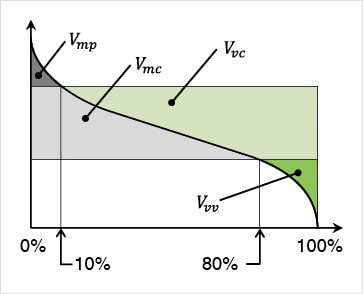Vmc (Core material volume)
This parameter represents the difference between the material volume at areal material ratio q% and the material volume at areal material ratio p%. It can also be used to quantify the magnitude of the core surface, reduced peaks, and reduced valleys based on volume parameters.
Vmp, Vmc, Vvc, and Vvv represent the volumes of the reduced peaks, core material, core void, and valley void, respectively.
To use volume parameters, you need to specify the areal material ratio values that divide the reduced peaks and reduced valleys from the core surface. By default, 10% and 80% are used.

